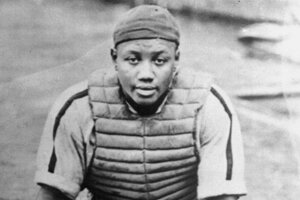Baseball steps up to a unifying plate
Combining the historical statistics of players from the Negro Leagues and Major League Baseball marks the latest progress in equality on and off the ball field.

Baseball catcher Josh Gibson in an undated photo. He became Major League Baseball's career leader with a .372 batting average, surpassing Ty Cobb's .367, when records of the Negro Leagues were incorporated with MLB statistics.
AP
A great milestone in professional baseball was that day in April 1947 when Jackie Robinson strode onto Ebbets Field in Brooklyn as the first Black player in the major leagues. That began the end of the Negro Leagues, which had consisted of mainly Black players because of forced segregation. Now, baseball has a new milestone.
Pro ball has revised its record books, aggregating statistics on player performance from both leagues going back decades. In this new telling, for example, Black player Josh Gibson replaces Ty Cobb, Hugh Duffy, and Barry Bonds as the game’s greatest hitter. The new records result from painstaking historical and statistical work to fairly compare the performances of players in leagues without comparable seasons.
But baseball statistics aren’t just about what happened on the field. They capture a history of integration – from the first Jewish and Italian ballplayers to today’s Asian phenoms. Like curtains peeled back, batting averages and stolen bases are narratives of lived experience, lenses on how different communities experience America and what ultimately binds them.
What emerges is a deeper story of persistent dignity and the pursuit of equality expressed through excellence. Hank Aaron once criticized Willie Mays for not speaking out more against racism. Yet the “Say Hey Kid” made his case for inclusivity through hustle and home runs.
“People ... may be uncomfortable with some Negro League stars now on the leaderboards for career and seasons,” Larry Lester, a baseball historian who served on the committee that combined the record books, told The New York Times. What matters, he says, is the conversations they spark.
Baseball’s more inclusive narrative is part of a broader reckoning with how Black people have mitigated racial inequality. In her 2021 study of unpublished Black literature from the early 20th century, for example, New York University English Professor Elizabeth McHenry chronicles a history of resistance and resilience in the face of segregation and rejection. The 2016 film “Hidden Figures” portrayed the role of NASA’s Black female mathematicians in the space program.
One effect of these reshaped narratives is more empathy and humility. Following the death of George Floyd in 2020, NFL Commissioner Roger Goodell said he wished “we had listened earlier” to professional football players kneeling during the national anthem to protest police violence.
A Stockholm University study on art and immigration noted last year how diverse societies are bound together by common points of reference. Harmony, or the “favourable conditions [of] a just, equal and inclusive society,” its author wrote, rests on a “collective consciousness” of shared values and rules.
Up until 1948, the ballplayers in the Negro Leagues confronted discrimination yet also dazzled fans and seeded Black journalism and entrepreneurship. But they were constantly told they were not good enough to face white ballplayers until Mr. Robinson broke the color barrier.
Now, the newly desegregated statistics of baseball’s segregated history “tell the story of the game, and the nation, inclusively,” as John Thorn, MLB’s official historian, told Rolling Stone. It is also a story of recognizing the innate talent of each individual, regardless of skin color.

